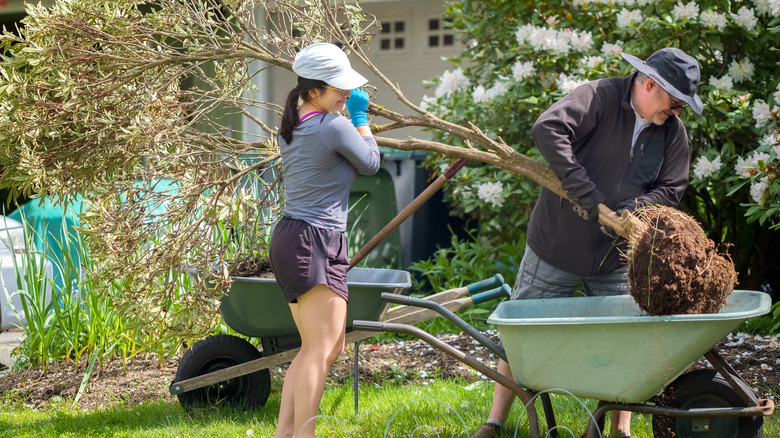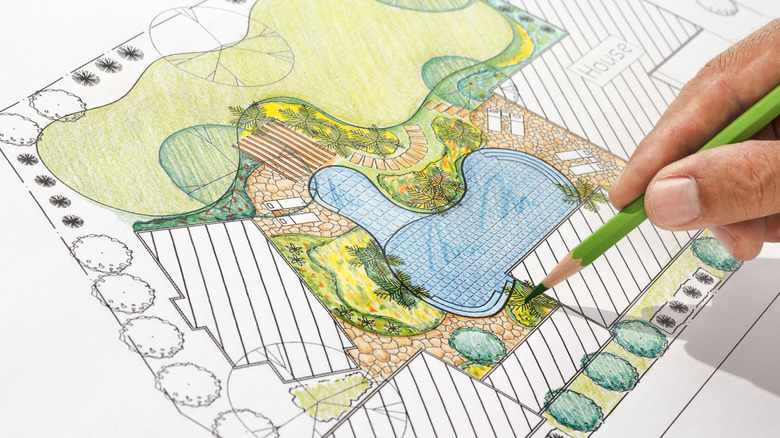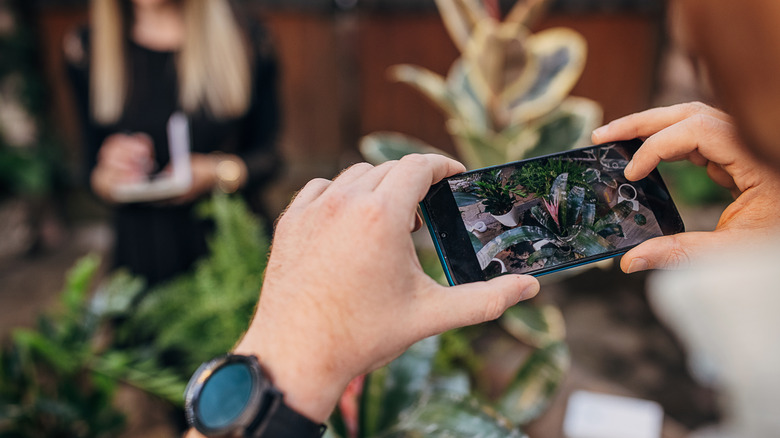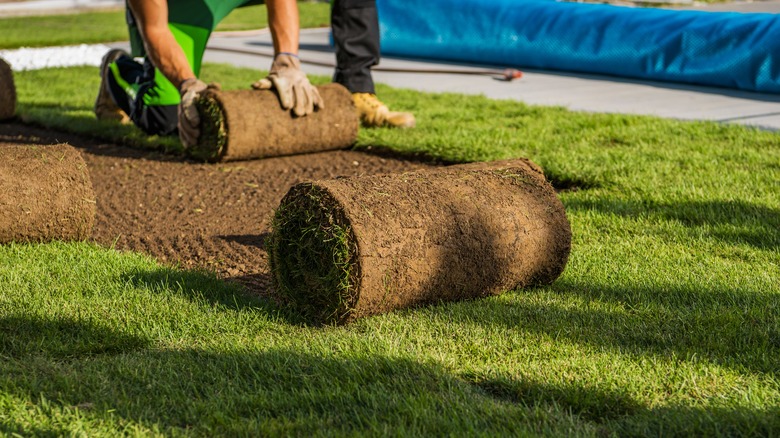What To Know Before Doing The Landscaping Yourself
Choosing to DIY your landscaping is a big undertaking. If you don't have a lot of experience with gardening, you might be better off beginning with a small collection of outdoor potted plants first, perhaps some that can be transplanted into the ground at a later date. But if you have several seasons under your belt, understand your soil, and know the amount of sunlight that different areas of your yard receives, planning your own landscaping can be a wonderful exercise in personal expression, know-how, and taste. However, there are several items to take into consideration before you break ground. It's important to make a plan, map out your yard, budget your time and money, do your research, and consult with the pros when necessary.
Attractive landscaping is beneficial for your home and your health in different ways. On a very practical level, landscaping your front yard improves your curb appeal, which can increase your property's value. It also supports a healthier environment by preventing soil erosion, providing a natural habitat for wildlife, and improving air quality. Finally, an improved outdoor living area made possible through landscaping boosts a person's quality of life, overall mood, and well-being. Plus, the physical labor involved in gardening can help keep you active and able-bodied.
Make a plan and plan to change
Start your DIY landscaping journey by planning out how you want your outdoor space to look. Consider what purposes you want it to serve, who will be using it, and how it will need to grow and change throughout the years you spend in your home. You'll want to make sure you include hardscapes like pathways, retaining walls, arbors, or other structures, as well as the softscapes of your plantings. And don't forget to consider the changing seasons, ensuring your yard has interest and beauty year-round.
This process is really more about brainstorming and making lists than tilling up any ground. If you have children, entertain often, or have a swimming pool, your backyard is going to have very specific needs that are different from others. Moreover, as you and your children age, your priorities and hobbies will evolve, so the yard needs to evolve with it. One of the best ways to plan for this is to implement the landscaping project in stages over several seasons. In the planning stage, make sure to differentiate between what you want to add first versus what elements can be added two or three years down the road. Unless you have a full home makeover TV show crew at your disposal, it's unlikely you can revamp your entire landscape in one planting season, so this planning stage helps you set a timeline and stay on track.
Map out your yard on paper
Chances are you haven't used graph paper since high school, but planning your landscape design is the perfect time to use some again. This doesn't have to be super detailed — it just has to be clear enough for you and anyone who's helping you to easily understand it. Using the general dimensions of your yard and basic shapes to denote your house and other permanent structures like sheds, large shade trees, and patios, sketch the space on your paper to better visualize your plan. Make sure you indicate which way is north as well so you can determine at a glance roughly where the light falls.
After you've sketched out your design and determined where you can put border plants, conifers, ornamental grasses, or maybe even a water feature, you can create a more precise blueprint on a separate sheet of graph paper using exact measurements. You can overlay these with tracing paper and create different design variations to illustrate the progression of the phases of your landscape plan, the changing seasonal interest of your proposed finished product, or whatever other creative intricacies you want to play around with. Use Google Earth Pro for better measurements. You can even try your hand at using Sketchup, a free 3D design modeling program, which will allow you to inspect your landscape design from every angle.
Make a timeline and budget your finances
Next, realistically calculate not just what the project will cost but also how long it will take to dig the soil, lay in your proposed plantings, and properly establish them in the ground, including waterings per day for the first few weeks. You don't want to spread yourself too thin, particularly if you're doing this all on your own. Yes, there may be enough hours in the day to install a three-tiered border bed all along your southern fencing, but the work will be taxing and you'll have other obligations as well, like meals or runs to the gardening supply store (which, money-wise, can also slow your progress as costs creep closer to your limit). Furthermore, daylight and weather are a factor as well.
Therefore, rather than trying to cram everything you want to do into a single weekend, spread it out over an entire planting season (or several, if you have an elaborate plan that can be implemented in phases) prioritized by the plants' own seasonal recommendations. For example, azalea bushes will bring a burst of color in early spring (with some varieties blooming again in fall), while the fall is a great time to plant a fast-growing medium-sized shade tree like the Chinese pistache. On the other hand, plants like ornamental grasses can be placed in the ground at any time during the year.
Research, research, research
Maybe you've always loved crepe myrtles, but you live in an area with icy winters, so your myrtle will die back every year. Perhaps you love the romance of a weeping willow but don't realize you should never plant it closer than 50 feet from any structure – including your home and your neighbors' homes. If you go into your DIY landscaping project picking plants based solely on what you like, you could be causing yourself several (expensive) headaches down the line. However, if you research the best plants for your area, your hardiness zone, your type of soil, and your specific needs, you'll have a much more rewarding landscaping experience.
The internet is a great starting point, but so is your local library with its hundreds of gardening tomes and periodicals. Plus, garden supply stores should have knowledgeable insight on the plants that thrive best in the area. This is also where your plan is necessary so you know what kinds of plants you're looking for. If you want shrubs that work as a privacy screen, ground cover plants aren't going to help you. If your kids want a butterfly garden, there are likely some blooms you've never even heard of that are perfect for your climate and the type of soil in your yard. If you're environmentally conscious, look into xeriscaping. Make sure you know exactly what you want and what you're getting so the plants you choose are the absolute best fit.
Don't hesitate to seek professional advice
Professional landscapers don't just do a whole project from start to finish; they can also step in and give advice or assistance at any point along the way. If you struggle envisioning what your yard could be beyond some grass and a swingset, a consultation with a landscape designer can help you answer that fundamental question. These consultations can be as broad or as detailed as you'd like, but the landscaper will be able to point you in a direction that fits your aesthetic and your budget. If it's the mapping you can't do, or you need a recommended plant list, or if there's a structure you want professionally installed, you can cherry pick these options as needed instead of, or in addition to, any others.
The average cost for a consultation with a landscape design company is $300, but this will be impacted by the type of consultation you're looking for and what other services, if any, you end up contracting through them. Likewise, any other costs will depend on how complex your overall plan is, including the size of the area and the number of special features it contains. Ultimately, professionals are here to help, so even if you intend to do everything yourself, put aside some money in your budget as an emergency fund in case you ever come across a problem you just can't fix on your own and try to find the best landscaper for the job.





